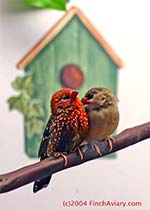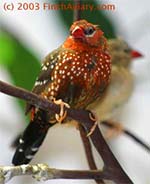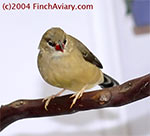|
THE
BIRDS IN OUR AVIARY
|
||||||||||||||
|
|
|
|||||||||||||
The Strawberry Finch The strawberries in my aviary are most noted for their beautiful song. It never fails to bring a smile to my face, and whenever I hear it, I have to stop and listen. I have captured a short audio clip of the strawberry song. This sound file was captured with my camcorder, uploaded and cropped via Pinnacle Studio DV, converted to WAV file via Virtual Dub, then the properties were modified via Sound Recorder to keep the file size small. In an effort to keep the file size small, quality is sacrificed (and let's face it, my camcorder isn't the best microphone in town either), so the clip doesn't do the birds justice. But it should give you the general idea: Strawberry Song (323 KB). The strawberries are the only waxbills I have in my aviary. They are noticeably smaller than the other birds in the aviary, with a shiny, wax-like, red beak. The males come into color during the summer, then lose their bright feathers again in the winter. I started out with only one pair (the unnamed pair). When first introduced into the aviary, the male would not leave the floor. He sat nervously between the food and water containers most of the time. I was very concerned about him. The female was not so nervous and would beckon to him from the branches, but he was either unable or unwilling to follow. After a few days, the male finally took flight, and when he did - boy did he ever. He always prefers the highest perch, where sometimes he will sit proud and sing his beautiful song. But he must have liked something about the bottom of the aviary, because to this day, this pair of strawberries still spend a lot of time sitting together on the bottom, watching the other birds eat and drink. Some time in the late summer of 1999, I saw a female strawberry finch at the local Petsmart. She was the only waxbill in a display overcrowded with Australian finches. I always feel sorry for pet shop birds, as the conditions are usually overcrowded and the diet is not very complete. I felt especially sorry for her, being the only one of her kind and unlikely to be purchased because she was so much higher priced than the other finches. But I do not like to buy from a pet store and support their practices. Plus, there is a higher risk of illness and general poor health due to inproper living conditions. So I did what I always do and walked away. Unfortunately, every time in the store, I always had to come look at the birds. Every time I came, she was still there - and always the only waxbill in the lot. My husband must have gotten tired of hearing me talk about her, because six months later (yes, she was still there and still alone), he bought her for me for Valentine's day. It is generally a bad practice to buy a bird that's been at the store that long, because it is likely to be in very poor health. But somehow, in spite of her conditions, she seemed to be thriving. I figured a bird that could handle that so well must be a darned hearty bird. And so she came home with us and got her name (Valentine). I didn't want to add her to the aviary after her quarantine because I was afraid she might create problems between the existing strawberries who were very closely bonded. So instead, we found her a male from a breeder and named the male Cupid. Cupid wasn't a perfect bird. His head is a little unshapely - kind of flat at the top, but since I am neither a breeder nor a show-er, I did not mind. And Valentine took to him right away. The first year that we had Cupid he did not come into color. I had heard that strawberries in captivity sometimes did not and so had given up on him ever donning the bright red feathers that mark the mating season. However, the next year, he surprised me - three months after my other male came into color, Cupid started his molt and low-and-behold - a beautiful coat of red feathers emerged. Cupid and Valentine lived in the large flight with our female societies. The new aviary is the first time that they will be in contact with the other strawberry pair. Two pairs of strawberries together may be a problem, so we might have to add a third pair to keep things calm (two pairs frequently become rivals, but three or more makes a flock). I've had two problems with the strawberries. The first is with their nails. Their nails grow faster than weeds. This is supposed to be a common problem among strawberries and some other waxbills. The second is the morning wake-up call. Cupid goes through stages where he wakes up before sun-up and emits piercing whistles that wake up the entire house. To ensure they didn't wake up my son, as soon as they would start, I would race downstairs and turn on all of the lights. For some reason, if the room was well-lit - everything would settle down again. When he went through the molt, this behavior stopped and hasn't started up again so far. However, I don't recommend keeping strawberries in your bedroom unless you are an early riser. Addendum: Shortly
after recording the song clip found above, my original male
strawberry passed away. The female, Lady, began calling for
him after he passed. I had never heard my female strawberries
make any such sound before. I recorded a clip that can be found
here: Female
Strawberry Call.
Click Previous to return to the Lady Gouldian Finch's page. Click Next to advance to the Canary's page. |
|
|
|
|
|
HOME | CONSTRUCTION
| CARE | BIRDS
| ACCESSORIES | BACKGROUND
AVICAM | GALLERY
| GUESTBOOK | LINKS
| SEARCH
SITE MAP | DISCLAIMER
| CONTACT US
(c)2005 FinchAviary.com



